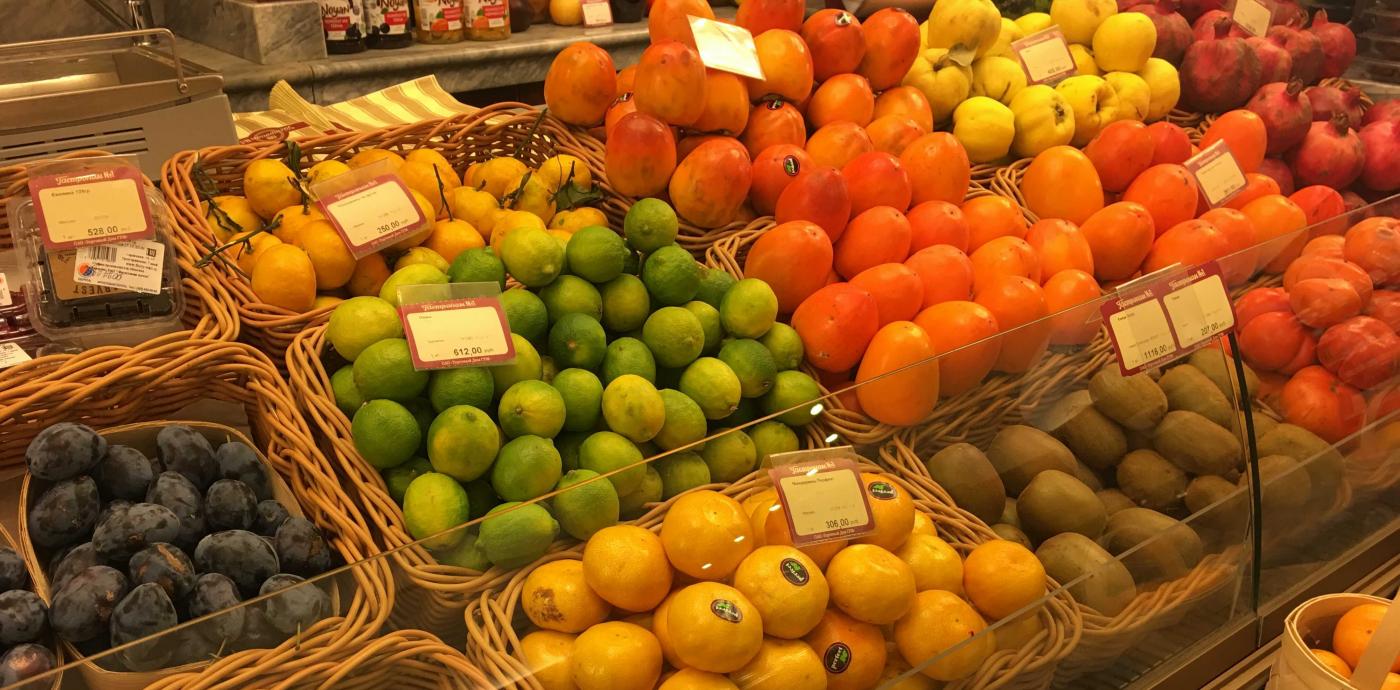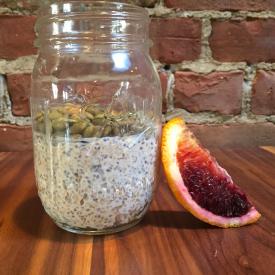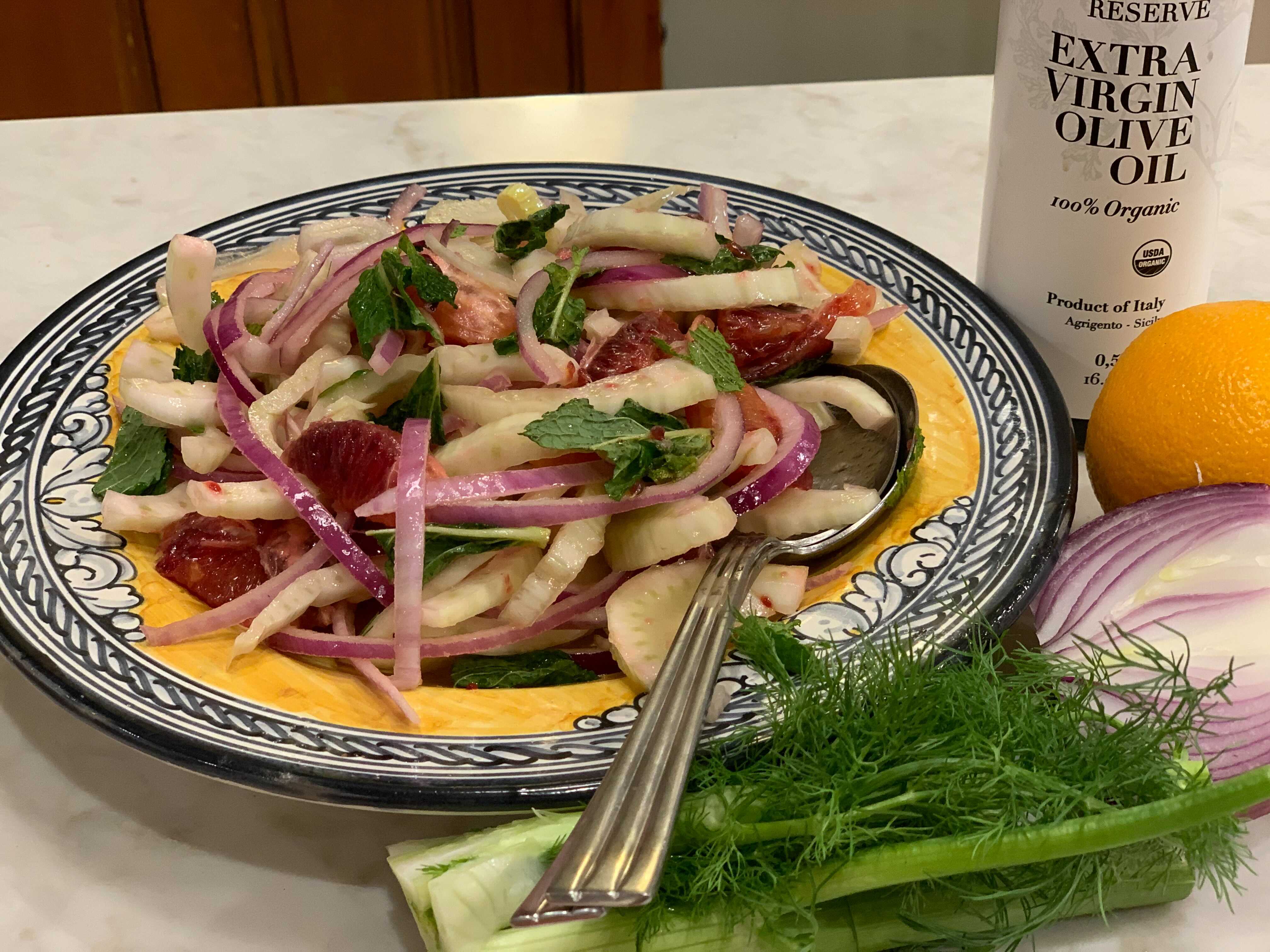Share This
Winter is citrus time, both in the United States and in the Mediterranean. Although we’re able to find lemons, limes, oranges, clementines, tangerines, grapefruit, and other citrus fruits all year long, this is the season to truly celebrate all that citrus fruits do to make Mediterranean cooking even more delicious.
While deliciousness is the number one reason to eat most foods, citrus is a winner in the health department too. We all know citrus comes with plenty of Vitamin C, but that’s not its only great feature. Citrus fruits provide fiber and other essential vitamins and minerals (such as vitamin A in grapefruit, and folate in oranges, an important nutrient for pregnant women and women planning to become pregnant). You’ll find citrus fruits at the base of the Mediterranean Diet Pyramid, with the advice to include these foods at every meal.
Although citrus fruits are major commercial products in the Mediterranean, citrus is not native to the region. Horticultural historians believe that citrus first came to the Mediterranean from Southeast Asia, India, and China. As noted in an article in the Journal of the American Society of Horticultural Science, historians believe that all the other citrus species are hybrids of three citrus types—citron (a large fragrant citrus fruit with a thick rind), pummelo (the largest citrus fruit and the principal ancestor of the grapefruit), and mandarin (an oblong orange citrus fruit with a thick skin).
Citrus fruits are all-day foods— breakfast, lunch, dinner— and they are perfect as an ingredient in appetizers, salads, dips or sauces, soups, main courses, vegetables, and dessert. Where to start!?
Breakfast, of course! Oranges, grapefruits, clementines and other citrus fruits solo are a great start to any day. Add them to granola, yogurt or both and you’ve stepped it up a notch. Try poaching citrus fruits with a variety of spices (cinnamon, cardamon, and vanilla are just a few) as a different topping for granola or yogurt, even whole grain pancakes (and be sure to reserve some to top ice cream or Greek yogurt for a great dessert!). If you love toasted bread for breakfast, any citrus marmalade is a luscious topping for whole grain toast.
Why not move beyond green salads for lunch and try a citrus salad? In her wonderful book, Mediterranean Cookery, Claudia Roden has a recipe for an Israeli Avocado and Citrus salad, combining slices of two ripe avocados with slices of one orange and one grapefruit, tossed with lemon juice, olive oil, salt and pepper, and garnished with mint. Another great winter citrus salad is a Sicilian one. Top this delicious combination of orange, fennel, and red onion with mint and olive oil. If green salads are your go-to-lunch, you can always add pieces of orange or grapefruit and dress the salad with the perfect Mediterranean olive oil and lemon dressing.
Nancy Harmon Jenkins writes about salad dressings and the best ratio between extra virgin olive oil and acid, whether it be vinegar or lemon juice in her classic book, The New Mediterranean Diet. Here’s Nancy’s recommendation when it comes to making a salad dressing: “Whether vinegar or lemon juice, acid should be added with a judicious hand. An acid dressing (in other words, too much acid) makes salad inappropriate to serve with wine, and there’s always wine to finish at the end of the meal and perhaps a bit of cheese to go with the salad. Ergo…a good oil-to-acid proportion is about three to one.” That is 3 parts extra virgin olive oil to 1 part lemon juice (or vinegar). Limes can also be used in salad dressings or vinaigrettes, and used to dress fish, meat, poultry or vegetables as well.
Writing in her always interesting blog, Aglaia and Costas’ Table on Kea, Cyclades, Aglaia Kremezi explained in a blog entitled, ‘Lemon is a Greek Perversion,’ that lemons were immediately adopted into Greek culinary arts because, “their fragrant sour juice perfectly complemented the rich-flavored Greek olive oil. Lemons soon replaced vinegar and the juices of unripe grapes, pomegranates, and all kinds of tart fruits that had been used to provide acidity to both sweet and savory dishes ever since antiquity.” Aglaia continues, “Anybody who has had even a single meal at a humble taverna or a formal restaurant on the mainland or the islands realizes how passionate Greeks are about the special acidic taste lemon adds to foods.” Lemons are served alongside almost everything in Greece whether it be fish, meat, soup, salads, or vegetables. Citrus is a wonderful partner for whole grain dishes, too. Try mixing and matching different whole grains with different citrus fruits.
Citrus soups are well loved in the Mediterranean, as well as other parts of the world. In the Mediterranean, the most well known and loved is the classic Greek soup (and sauce) avgolemono, a mixture of broth, egg yolk, and lemon. Another wonderful soup adds a combination of citrus juices to chicken and pasta soups. Even Turkish red lentil soup is improved upon by adding a squirt of citrus to the tender lentils and tomatoes.
Roasted vegetables are another way to add some citrus-y zest. Grapefruit, oranges, lemons are all perfect partners for roasted, sautéed or steamed vegetables. Charred carrots with orange juice and zest is a great example of how citrus can make a plain dish burst with flavor. Nancy Jenkins reminds us that in Morocco, the same combination is served as part of the first course in small bowls with spoons. She says, “freshly squeezed orange juice is essential here.”
Citrus is, of course, a splendid ending to any meal, just by itself. On the other hand, there are any number of ways to incorporate citrus into Mediterranean desserts. In the Italian region of Campania, on the Amalfi Coast, there are two kinds of lemons that are so special they are protected IGP, which guarantees a product is grown or produced in a particular region or a country and that the quality, recipe, and characteristics can be traced back to its geographical origin. The region is known for desserts featuring lemons, such as Melissa Clark’s Baba Limoncello with Lemon Cream, or Limoncello, the lemon liqueur. If you want to learn more about citrus in this part of the Mediterranean, join us in October for Oldways Naples + Amalfi Culinaria!
Olive oil cakes are a great way to incorporate citrus, whether it be orange, blood orange, lemon, or Meyer Lemon, or even a combination of all! Citrus fruits baked in parchment is another easy to way to end your meal with citrus fruit. Also, candied citrus peels are a delicious addition to the top of a cake, or enjoyed as a bit of sweetness at the end of a meal.
A word about preserved lemons, a condiment used in North African cooking, that adds an umami punch and depth to cooking. Julia Moskin writes in The New York Times, “that New York chefs add the minced peel to salads and garnish fried seafood with it; the cured-lemon flavor is particularly friendly to salmon, carrots, olives, parsley and potatoes. The lemony brine is great in a bloody mary!” Paula Wolfert’s recipe is the classic, whether or not the optional spice mixture is used.
There are many more fruits in the citrus family than are covered here. The list is very long and we urge you to see and learn about some of the other, less familiar citrus fruits. We also hope you’ll make your winter a little brighter by experimenting and trying to include citrus in as many ways as you can. You’ll be happy you did. For more ideas, try the recipes included in this week’s Fresh Friday and be sure to check out Oldways 12 Great Ways to Use Citrus.
Want biweekly Med Diet information and recipes in your Inbox? Sign up for our Fresh Fridays newsletter by clicking the Subscribe button at the bottom of this page!
Join the Make Every Day Mediterranean Club Facebook group for additional information and support.






Comments
Add a Comment